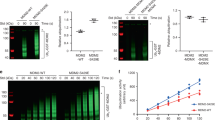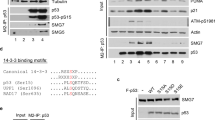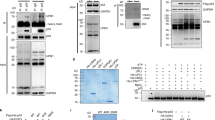Abstract
Mutant-type p53 (mt p53) is largely accumulated in cancer cells due to its increased stability. To elucidate the mechanism of mt p53 stabilization, we analysed the turnover of p53 mutated at codon 248 whose alteration is most frequently found in human cancers. Proteasome inhibition induced the accumulation of ubiquitinated mt p53, indicating that the ubiquitinated forms were essentially unstable and degraded by the proteasome. The presence of a small amount of the ubiquitinated mt p53 relative to the abundant non-ubiquitinated form suggested that the mt p53 ubiquitination was a rate-limiting process in the slow turnover. Two phenomena destabilizing mt p53 via the ubiquitin-proteasome degradation were proved to be independent. First, the coexpression of wild-type p53 (wt p53) promoted mt p53 destabilization as feedback regulation. Second, geldanamycin also induced mt p53 destabilization through the dissociation of the protein from hsp90 but not through the restoration of wt p53 function. Neither the mutant-specific conformation nor the N-terminal phosphorylation seemed to contribute directly to the mt p53 stabilization. Further, a two-dimensional gel electrophoresis revealed that most of the post-translationally modified mt p53 was equally subjected to ubiquitination and subsequent proteasomal degradation. These findings are evidence that mt p53 stabilization depends on the impaired ubiquitination due to both the loss of wt p53 function and the hsp90 association.
This is a preview of subscription content, access via your institution
Access options
Subscribe to this journal
Receive 50 print issues and online access
$259.00 per year
only $5.18 per issue
Buy this article
- Purchase on Springer Link
- Instant access to full article PDF
Prices may be subject to local taxes which are calculated during checkout







Similar content being viewed by others
References
Aoyama N, Nagase T, Sawazaki T, Mizuguchi G, Nakagoshi H, Fujisawa JI, Yoshida M and Ishii S. . 1992 Proc. Natl. Acad. Sci. USA 89: 5403–5407.
Blagosklonny MV. . 1997 Oncogene 15: 1889–1893.
Blagosklonny MV, Toretsky J, Bohen S and Neckers L. . 1996 Proc. Natl. Acad. Sci. USA 93: 8379–8383.
Blagosklonny MV, Toretsky J and Neckers L. . 1995 Oncogene 11: 933–939.
Brown JP and Pagano M. . 1997 Biochim. Biophys. Acta 1332: 1–6.
Chen L, Agrawal S, Zhou W, Zhang R and Chen J. . 1998 Proc. Natl. Acad. Sci. USA 95: 195–200.
Cho Y, Gorina S, Jeffrey PD and Pavletich NP. . 1994 Science 265: 346–355.
Chowdary DR, Dermody JJ, Jha KK and Ozer HL. . 1994 Mol. Cell. Biol. 14: 1997–2003.
Ciechanover A, DiGiuseppe JA, Bercovich B, Orian A, Richter JD, Schwartz AL and Brodeur GM. . 1991 Proc. Natl. Acad. Sci. USA 88: 139–143.
Cordon-Cardo C, Latres E, Drobnjak M, Oliva MR, Pollack D, Woodruff JM, Marechal V, Chen J, Brennan MF and Levine AJ. . 1994 Cancer Res. 54: 794–799.
Coux O, Tanaka K and Goldberg AL. . 1996 Ann. Rev. Biochem. 65: 801–847.
Dittmer D, Pati S, Zambetti G, Chu S, Teresky AK, Moore M, Finlay C and Levine AJ. . 1993 Nat. Genet. 4: 42–46.
Felgner PL, Gadek TR, Holm M, Roman R, Chan HW, Wenz M, Northrop JP, Ringold GM and Danielsen M. . 1987 Proc. Natl. Acad. Sci. USA 84: 7413–7417.
Fritsche M, Haessler C and Brandner G. . 1993 Oncogene 8: 307–318.
Gannon JV, Greaves R, Iggo R and Lane DP. . 1990 EMBO J. 9: 1595–1602.
Hall PA, Meek D and Lane DP. . 1996 J. Pathol. 180: 1–5.
Harris CC. . 1996 J. Natl. Cancer Inst. 88: 1442–1455.
Hartwell LH and Kastan MB. . 1994 Science 266: 1821–1828.
Haupt Y, Maya R, Kazaz A and Oren M. . 1997 Nature 387: 296–299.
Hiller MM, Finger A, Schweiger M and Wolf DH. . 1996 Science 273: 1725–1728.
Hochstrasser M. . 1996 Annu. Rev. Genet. 30: 405–439.
Jeffers M, Taylor GA, Weidner KM, Omura S and Vande Woude GF. . 1997 Mol. Cell. Biol. 17: 799–808.
Kastan MB, Onyekwere O, Sidransky D, Vogelstein B and Craig RW. . 1991 Cancer Res. 51: 6304–6311.
Kondo S, Barnett GH, Hara H, Morimura T and Takeuchi J. . 1995 Oncogene 10: 2001–2006.
Kubbutat MH, Jones SN and Vousden KH. . 1997 Nature 387: 299–303.
Kubbutat MH and Vousden KH. . 1997 Mol. Cell. Biol. 17: 460–468.
Landers JE, Cassel SL and George DL. . 1997 Cancer Res. 57: 3562–3568.
Legros Y, Meyer A, Ory K and Soussi T. . 1994 Oncogene 9: 3689–3694.
Levine AJ, Perry ME, Chang A, Silver A, Dittmer D, Wu M and Welsh D. . 1994 Br. J. Cancer 69: 409–416.
Maki CG, Huibregtse JM and Howley PM. . 1996 Cancer Res. 56: 2649–2654.
Medcalf EA and Milner J. . 1993 Oncogene 8: 2847–2851.
Milner J and Medcalf EA. . 1991 Cell 65: 765–774.
Miyaji H, Mizukami T, Hosoi S, Sato S, Fujiyoshi N and Itoh S. . 1990 Cytotechnology 3: 133–140.
Miyake H, Hanada N, Nakamura H, Kagawa S, Fujiwara T, Hara I, Eto H, Gohji K, Arakawa S, Kamidono S and Saya H. . 1998 Oncogene 16: 933–943.
Miyata Y and Yahara I. . 1992 J. Biol. Chem. 267: 7042–7047.
Musti AM, Treier M and Bohmann D. . 1997 Science 275: 400–402.
Pagano M. . 1997 FASEB J. 11: 1067–1075.
Pratt WB and Toft DO. . 1997 Endocr. Rev. 18: 306–360.
Prodromou C, Roe SM, O'Brien R, Ladbury JE, Piper PW and Pearl LH. . 1997 Cell 90: 65–75.
Roth JA and Cristiano RJ. . 1997 J. Natl. Cancer Inst. 89: 21–39.
Save V, Nylander K and Hall PA. . 1998 J. Pathol. 184: 348–350.
Scheffner M, Huibregtse JM, Vierstra RD and Howley PM. . 1993 Cell 75: 495–505.
Selkirk JK, Merrick BA, Stackhouse BL and He C. . 1994 Appl. Theor. Electrophor. 4: 11–18.
Sharma SV, Agatsuma T and Nakano H. . 1998 Oncogene 16: 2639–2645.
Shieh SY, Ikeda M, Taya Y and Prives C. . 1997 Cell 91: 325–334.
Soussi T and May P. . 1996 J. Mol. Biol. 260: 623–637.
Stebbins CE, Russo AA, Schneider C, Rosen N, Hartl FU and Pavletich NP. . 1997 Cell 89: 239–250.
Steegenga WT, van der Eb AJ and Jochemsen AG. . 1996 J. Mol. Biol. 263: 103–113.
Ullrich SJ, Mercer WE and Appella E. . 1992 Oncogene 7: 1635–1643.
Vojtesek B, Dolezalova H, Lauerova L, Svitakova M, Havlis P, Kovarik J, Midgley CA and Lane DP. . 1995 Oncogene 10: 389–393.
Whitesell L, Sutphin PD, Pulcini EJ, Martinez JD and Cook PH. . 1998 Mol. Cell. Biol. 18: 1517–1524.
Wiech H, Buchner J, Zimmermann R and Jakob U. . 1992 Nature 358: 169–170.
Zambetti GP and Levine AJ. . 1993 FASEB J. 7: 855–865.
Acknowledgements
We thank Drs H Koga and N Araki (Kumamoto University School of Medicine) for their technical assistance; Drs Q Hu, N Aoyama (Kobe University) and C Miyamoto (Roche Research Center) for providing the pCGN expression vector, 248Trp and αp53-deg antibody, respectively; and T Arino for secretarial assistance. This work was supported by a Grant-in-Aid for Scientific Research on Priority Areas from the Ministry of Education, Science and Culture, Japan (M Nakao).
Author information
Authors and Affiliations
Rights and permissions
About this article
Cite this article
Nagata, Y., Anan, T., Yoshida, T. et al. The stabilization mechanism of mutant-type p53 by impaired ubiquitination: the loss of wild-type p53 function and the hsp90 association. Oncogene 18, 6037–6049 (1999). https://doi.org/10.1038/sj.onc.1202978
Received:
Revised:
Accepted:
Published:
Issue Date:
DOI: https://doi.org/10.1038/sj.onc.1202978
Keywords
This article is cited by
-
Focal p53 protein expression and lymphovascular invasion in primary prostate tumors predict metastatic progression
Scientific Reports (2022)
-
Mechanical cues control mutant p53 stability through a mevalonate–RhoA axis
Nature Cell Biology (2018)
-
The HSP90 chaperone machinery
Nature Reviews Molecular Cell Biology (2017)
-
Combined HSP90 and kinase inhibitor therapy: Insights from The Cancer Genome Atlas
Cell Stress and Chaperones (2015)
-
S100A2 is a BRCA1/p63 coregulated tumour suppressor gene with roles in the regulation of mutant p53 stability
Cell Death & Disease (2014)



